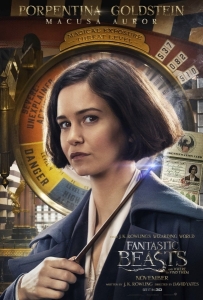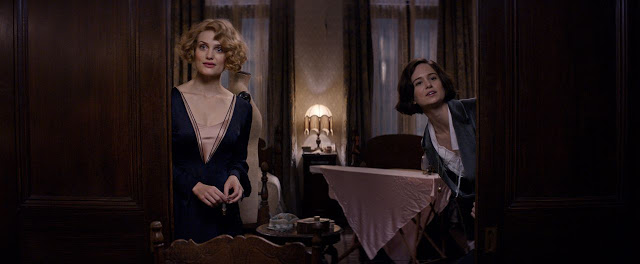While I’m not a Harry Potter superfan (no HP tattoos here), I definitely loved the books and movies growing up. The chance to return to the HP universe on film was both exciting and nostalgia-inducing, much like reading the Cursed Child screenplay. I entered the theater with cautious optimism and minimal exposure to any movie spoilers, and fortunately I left the theater feeling mostly satisfied.
However, “mostly satisfied” pales in comparison to the magical, whimsical, enthrallment the other HP films and books induced. On the scale of Star Wars: Episode 1 to Toy Story 3, I place Fantastic Beasts firmly in Monsters University sequel/prequel territory: Not as good as the first one (or in this case, first 8), but it adds something to the universe without sacrificing the original story. It’s also important to note that, as a white woman, my being “mostly satisfied” with the film also hinges on the fact that the film represented a white American culture I don’t feel excluded from.
It doesn’t perform as well as I’d hoped on the Her Story Arc Scale of Inclusivity:
 Not offensive to women 0/1 points
Not offensive to women 0/1 points
- Features a woman as the main protagonist and/or supporting character 2/2 points
- Passes the Bechdel Test 3/3 points
- Artistic and/or entertaining 3/4 points
- Above and beyond general media 1/5 points
Total points = 9/15
Let’s start with the good news, there are a lot of women featured in the movie. They have unique personalities, meaningful contributions to the film, and YES, two of them do talk to each other about something other than a man, albeit briefly. The Bechdel Test is passed when the former-Auror Tina speaks with President Seraphina at the US Ministry.






In addition to the plethora of women characters, the fact that Seraphina is a black, female President in 1920’s America is really cool. She commands the room and the scene whenever she is present, and the characters around her obviously respect her. Choosing to depict a black, female president indicates the wizarding world is years ahead of non-magical American culture. As Keisha Hatt at TheMarySue.com notes in her review, “This movie takes place just seven years after women were granted the right to vote”.
Then there are the Goldstein sisters. Tina and Queenie represent the options that feminism allows in the magical world. Tina wears pants, has career ambitions, and is internally driven to do what is right. Queenie is comfortable in her femininity, sacrifices none of her agency to patriarchal notions, and is equally as driven as her sister to do what is right. No one questions the integrity or choices of either sister. Perhaps more importantly, the two sisters generally accept one another’s differences and aren’t undermining each other.
I have given a lot of thought to Queenie as a character since leaving the theater. I personally did not like how she was introduced to us wearing a silk shift, delighted to see men, and painfully slow in getting dressed. That being said, Queenie is completely in control in every scene we see her in. She leverages her femininity and magical empathy (arguably the most feminine magic possible) to her advantage. Her ability to read thoughts, intentions, and emotions makes her incredibly powerful. Part of her ability to harness that power is through keeping it a secret. Only her sister knows about it before Newt and Kowalksi come along.
Now for the not-so-great things about this film. Other than President Seraphina, there are no other people of color among the major characters. There is also a noticeable absence of LGBT+ characters and no character with a disability.
To make matters worse, there is an uncomfortable scene at a magical speakeasy featuring a singing, animated goblin. After the film both my husband and I discussed the strange implications of this scene. At TheNerdsofColor.org, writer Clara Mae had this to say:
“This single inclusion was maddeningly confusing and unnecessary. The goblin is clearly coded as Black, which forces us to contemplate the confounding question of whether or not goblins even have ethnicities. In a film largely lacking in people of color, was it necessary to have a goblin, of all things, be coded in this way? Why in the world couldn’t Aretha Ayeh have just played an actual human woman?”
I agree wholeheartedly with Clara that having Aretha Ayeh, who voices the character, play a human witch would have made the scene much more enjoyable.
Then there is the continued problem with J.K. Rowling and her depiction of magic in North America, which appropriates indigenous culture. Fantastic Beasts and Where to Find Them could have been used as an opportunity to right some wrongs, but the film does nothing to incorporate Native Americans into the magical conversation and doubles down on the Ilvermorny School of Witchcraft and Wizardry back story.
For these reasons, the film did not earn any points for being non-offensive, and only earned one out of five points for going above and beyond general media.
Ultimately, the strides the movie takes with white, female representation does not and can not make up for the lack of diversity. However, there is hope the next three films will improve. Leta Lestrange was only featured momentarily in a photograph, but she is rumored to play a large role in the sequel. There were also several Aurors of color that could (and should) have speaking roles going forward.
- “Dear JK Rowling: We’re Still Here” by NativesInAmerica.com
- “Fantastic Beasts is Not So Fantastic on Diversity” by TheNerdsofColor.org
Want more from F-BOM? Sign up for our newsletter!



Noone mentioned how of course the beautiful smart seductive woman falls in love with an unattractive uninteresting man…
LikeLike
Nice review! I was a bit disappointed by the lack of representation with the jazz age in general and how Rowling has dealt with the indigenous misrepresentation as well. The movie felt like it came out of the 1920s, but I felt like it missed the vibrancy of what made that era. Zoe Kravitz is a big reason I’m excited for the sequels and am hoping she has a complex, interesting character. Here’s looking forward to the future installments!
LikeLiked by 1 person
I completely agree that this was a missed opportunity to spotlight the importance of jazz in the 20’s. Knock on wood the second film exceeds the first in more ways than one.
LikeLike
I read an article and it mentioned that there should have been more minority representation because this is the time of jazz. Jazz really was successful because of people of color so you think there would be more representation here.
LikeLiked by 1 person
It really does feel like a missed opportunity doesn’t it!
LikeLike
Yeah I think so!
LikeLike